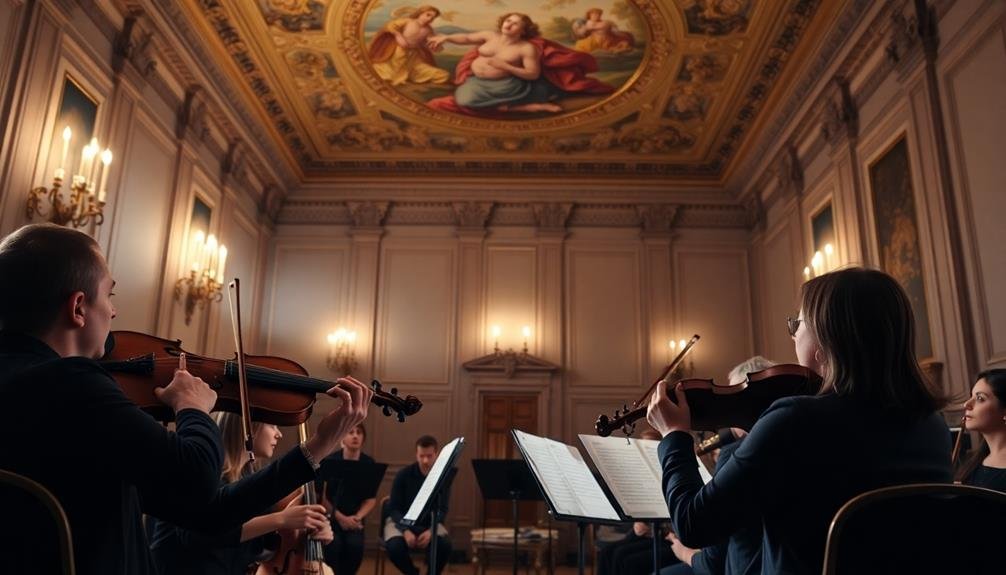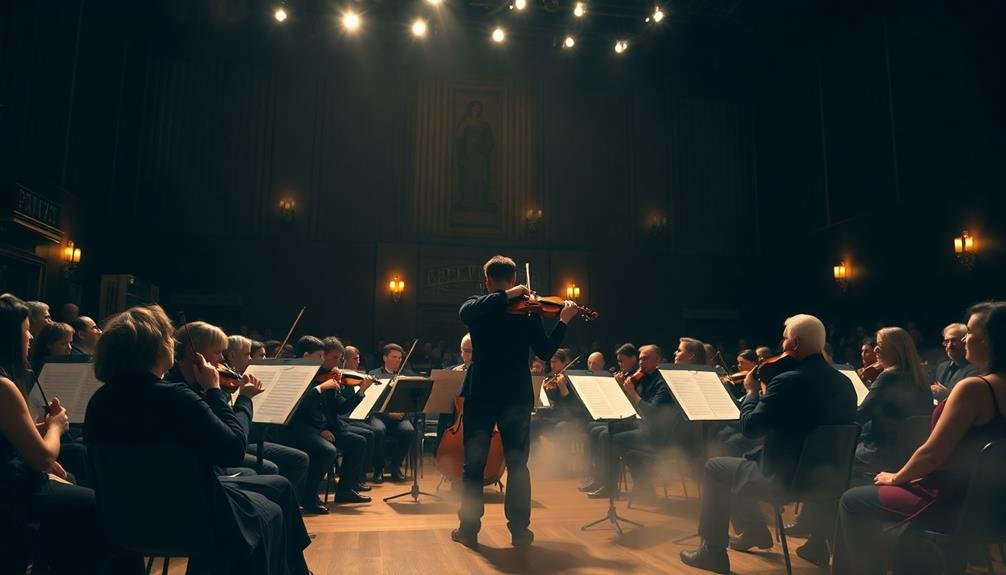Classical music can be a powerful tool to melt away anxiety. You'll find solace in Bach's "Air on the G String," with its flowing melody and stable bass line. Debussy's "Clair De Lune" offers ethereal piano notes that create a calming atmosphere. Beethoven's "Moonlight Sonata" soothes with its haunting melody and gentle tempo. Mozart's "Piano Concerto No. 21" eases the mind with gentle harmonic progressions. Chopin's "Nocturne Op. 9 No. 2" unfolds like a soothing lullaby. These pieces, along with works by Grieg, Albinoni, Brahms, and Mendelssohn, can help reduce stress and promote relaxation. Exploring their unique qualities can reveal even more anxiety-relieving benefits.
Bach's Air on the G String

Serenity washes over you as the gentle strains of Bach's Air on the G String begin. This iconic piece, originally part of Bach's Orchestral Suite No. 3 in D major, has become a standalone favorite for its calming qualities.
As you listen, you'll notice the slow, flowing melody that seems to suspend time, allowing your mind to unwind and your body to relax.
The piece's structure is simple yet profound, with a repeating bass line that provides a steady foundation for the soaring violin melody. This combination creates a sense of stability and predictability, which can help ease anxious thoughts.
The rich, warm tones of the string instruments further enhance the soothing effect, enveloping you in a cocoon of sound.
You'll find that focusing on the intricate interplay between the instruments can serve as a form of meditation, directing your attention away from worries and into the present moment.
As the piece progresses, you may feel your breathing slow and your muscles release tension.
Debussy's Clair De Lune
Debussy's masterpiece, "Clair de Lune," transports you to a moonlit reverie with its ethereal piano notes. As you listen, you'll find yourself enveloped in a gentle, dream-like atmosphere that slowly eases your anxious thoughts.
The piece's soft dynamics and flowing melody create a sense of calm, allowing your mind to unwind and your body to relax.
"Clair de Lune" is particularly effective in reducing anxiety due to its:
- Slow tempo, which naturally slows your heart rate and breathing
- Use of rubato, creating a fluid, unhurried feeling
- Delicate harmonies that soothe rather than stimulate
- Gradual dynamic changes that avoid jarring contrasts
As you immerse yourself in the music, you'll notice how Debussy's impressionistic style paints a vivid picture of moonlight reflecting on water. This imagery can help shift your focus away from stressful thoughts, providing a mental escape.
The piece's structure, with its gradual build and release of tension, mirrors the process of anxiety reduction itself. By the time you reach the final, gently fading notes, you'll likely find yourself in a notably more relaxed state, ready to face your challenges with renewed calm.
Beethoven's Moonlight Sonata
While less ethereal than Debussy's work, Beethoven's "Moonlight Sonata" offers its own unique approach to calming anxiety. This iconic composition, officially titled "Piano Sonata No. 14 in C-sharp minor," is renowned for its haunting melody and gentle tempo.
As you listen to the first movement, you'll notice the soothing, repetitive pattern in the right hand, creating a hypnotic effect that can help quiet racing thoughts. The left hand's steady, deep notes provide a grounding presence, much like a slow, controlled breathing exercise.
The piece's slow tempo encourages you to synchronize your breath with the music, naturally slowing your heart rate and promoting relaxation. Beethoven's use of minor keys adds a touch of melancholy, allowing you to acknowledge and process any underlying emotions.
For maximum anxiety relief, find a quiet space, close your eyes, and focus solely on the music. Let the gentle arpeggios wash over you, imagining each note dissolving tension in your body.
Mozart's Piano Concerto No. 21
Mozart's Piano Concerto No. 21 offers you a serene escape from anxiety through its calming melodic flow.
You'll find gentle harmonic progressions that ease your mind and soothe your nerves.
The piece's rhythmic patterns create a tranquil atmosphere, helping you relax and find inner peace.
Calming Melodic Flow
For centuries, classical music has been renowned for its soothing qualities, and Mozart's Piano Concerto No. 21 stands out as a prime example of calming melodic flow. As you listen to this masterpiece, you'll notice how the gentle piano notes seem to cascade like a tranquil stream, washing away your worries and anxiety.
The concerto's second movement, known as "Andante," is particularly effective in reducing stress. Its serene tempo and harmonious progression create an atmosphere of peace and tranquility. You'll find yourself swept away by the music's graceful ebb and flow, which mirrors the natural rhythms of relaxation.
Mozart's genius shines through in the way he crafted this piece to engage your mind while simultaneously calming your nerves. The melodic flow:
- Encourages deep, steady breathing
- Lowers heart rate and blood pressure
- Promotes a sense of emotional balance
- Distracts from anxious thoughts
As you immerse yourself in the soothing sounds of Piano Concerto No. 21, you'll feel your tension melting away. The music's structure provides a sense of predictability and order, helping to quiet racing thoughts and restore inner calm.
Gentle Harmonic Progressions
The gentle harmonic progressions in Mozart's Piano Concerto No. 21 play a key role in its anxiety-reducing effects. As you listen, you'll notice how Mozart masterfully crafts a series of chord changes that flow seamlessly from one to the next. This smooth shift between harmonies creates a sense of predictability and stability, which can help soothe your anxious mind.
The concerto's second movement, known as "Andante," is particularly effective in this regard. You'll hear how the piano and orchestra engage in a delicate dance, with harmonies that resolve in satisfying ways. This resolution provides a feeling of completion and closure, which can be deeply comforting when you're experiencing anxiety.
Mozart's use of major keys throughout much of the piece contributes to its uplifting quality. These bright, open harmonies can help lift your mood and create a sense of optimism.
As you immerse yourself in the music, pay attention to how the harmonic progressions guide you through a range of emotions, ultimately leading to a sense of calm and balance. This gentle journey through harmonies can help reset your nervous system and alleviate anxiety symptoms.
Soothing Rhythmic Patterns
Rhythmic stability forms the backbone of Mozart's Piano Concerto No. 21, offering a soothing effect for listeners struggling with anxiety. The piece's second movement, known as "Andante," showcases a gentle, recurring rhythm that can help calm your nerves. As you listen, you'll notice the steady, predictable patterns that create a sense of order and tranquility.
The soothing rhythmic patterns in this concerto are characterized by:
- A consistent tempo that's neither too slow nor too fast
- Repetitive motifs that provide a sense of familiarity
- Smooth shifts between musical phrases
- Balanced interplay between the piano and orchestra
These elements work together to create a comforting auditory environment. You'll find that the rhythmic consistency allows your mind to settle into a peaceful state, reducing racing thoughts and tension.
The piece's gentle pulse can even help regulate your breathing, promoting relaxation. As you immerse yourself in the music, you may notice your heart rate slowing and your muscles relaxing.
Mozart's Piano Concerto No. 21 proves that sometimes, the most effective anxiety relief comes from simple, steady rhythms that ground you in the present moment.
Chopin's Nocturne Op. 9 No. 2

You'll find Chopin's Nocturne Op. 9 No. 2 to be a balm for anxious minds.
Its gentle melodic progression unfolds like a soothing lullaby, easing tension with each note.
The piece's rhythmic patterns create a tranquil atmosphere, inviting you to relax and let your worries melt away.
Gentle Melodic Progression
Frédéric Chopin's Nocturne Op. 9 No. 2 stands out as a prime example of gentle melodic progression in classical music. As you listen, you'll notice how the melody gracefully flows from one note to the next, creating a soothing and harmonious experience. This piece's gentle progression is key to its anxiety-reducing effects.
The melodic line moves in a way that's both predictable and surprising, keeping your mind engaged without overwhelming it. You'll find:
- Smooth shifts between phrases
- Gradual rises and falls in pitch
- Repeated motifs that build familiarity
- Subtle variations that maintain interest
These elements work together to create a sense of calm and stability. As the melody unfolds, you'll feel your tension melting away, replaced by a feeling of tranquility.
The piece's gentle progression allows your mind to relax and focus on the present moment, effectively reducing anxiety.
Soothing Rhythmic Patterns
Beyond its gentle melodic progression, Chopin's Nocturne Op. 9 No. 2 offers soothing rhythmic patterns that contribute considerably to its anxiety-reducing qualities. The piece's consistent, flowing rhythm creates a sense of stability and predictability, which can help calm an anxious mind.
You'll notice the left hand maintains a steady, unbroken triplet pattern throughout the piece. This repetitive rhythmic foundation acts as an anchor, providing a soothing, almost hypnotic effect. The right hand's melody, while more varied, still adheres to a gentle rhythmic structure that complements the left hand's consistency.
The overall tempo of the Nocturne is moderate and unhurried, allowing you to synchronize your breathing with the music's natural pulse. This can help slow your heart rate and reduce physical symptoms of anxiety.
Additionally, the piece's rhythmic patterns create a sense of forward motion without urgency, encouraging a state of relaxed focus.
Satie's Gymnopédie No. 1
Erik Satie's "Gymnopédie No. 1" stands as a pillar of tranquility in the classical music world. This gentle, melancholic piece can transport you to a place of calm and introspection. As you listen, you'll notice the slow, deliberate tempo and the simple, repetitive melody that creates a hypnotic effect.
The composition's minimalist approach is key to its anxiety-reducing properties. You'll find:
- A sparse, uncluttered arrangement
- Gentle, swaying rhythms
- Soft, muted tones
- A sense of timelessness and suspension
Satie's unconventional harmonies and lack of dramatic crescendos keep your mind from wandering or becoming agitated. The piece's steady, predictable nature allows your nervous system to relax and your breathing to slow down naturally.
As you immerse yourself in "Gymnopédie No. 1," you might find your thoughts becoming clearer and your worries fading into the background. It's an ideal choice for meditation, relaxation before sleep, or as a calming backdrop during stressful moments.
Let Satie's masterpiece guide you to a state of serene contemplation and inner peace.
Handel's Water Music Suite

You'll find Handel's Water Music Suite brimming with soothing Baroque melodies that can ease your anxious mind.
This masterpiece was originally composed for a royal celebration on the River Thames, creating a serene atmosphere that you can now enjoy anywhere.
As you listen, you'll be transported to a tranquil riverside scene, where the gentle ebb and flow of the music mirrors the calming waters.
Soothing Baroque Melodies
Handel's Water Music Suite stands out as a prime example of soothing Baroque melodies. As you listen to this masterpiece, you'll find yourself transported to a world of gentle harmonies and flowing rhythms. The suite's calming nature stems from its origins as entertainment for a royal boat trip along the Thames River.
You'll notice several key elements that contribute to the suite's anxiety-reducing qualities:
- Consistent, steady rhythms that mimic the gentle lapping of water
- Melodic lines that gracefully interweave, creating a sense of balance
- Warm, rich tones from the string and wind instruments
- Repetitive patterns that provide a comforting sense of predictability
As you immerse yourself in Handel's Water Music, you'll feel your stress melting away. The music's gentle ebb and flow can help regulate your breathing and lower your heart rate.
It's an ideal choice for background music during meditation or relaxation exercises. Whether you're winding down after a long day or seeking a moment of calm during a hectic schedule, this Baroque gem offers a musical sanctuary for your mind and soul.
Royal River Celebration
While Handel's Water Music Suite is renowned for its calming qualities, it's also a demonstration of the grandeur of royal celebrations. Composed for King George I's river journey on the Thames, this suite combines elegance with soothing melodies that can help ease your anxiety.
As you listen, imagine yourself transported to the 18th century, drifting along the river surrounded by ornate barges and jubilant crowds. The suite's three movements offer varying tempos and moods, allowing you to find the perfect rhythm for relaxation.
| Movement | Mood | Anxiety-Reducing Effect |
|---|---|---|
| Overture | Majestic | Grounding and centering |
| Alla Hornpipe | Lively | Mood elevation |
| Air | Tranquil | Deep relaxation |
You'll find the brass and wind instruments particularly effective in dispersing anxious thoughts. The horn passages evoke a sense of open space, while the flutes and oboes create a light, airy atmosphere. As the music ebbs and flows, let your worries drift away with the imaginary current. Handel's Water Music Suite isn't just a historical piece; it's a timeless remedy for modern stress.
Vivaldi's Four Seasons: Spring
From the vibrant opening notes of "Spring" in Vivaldi's Four Seasons, you're instantly transported to a world of renewal and hope. The composition's lively tempo and sparkling melodies mirror nature's reawakening, helping to lift your spirits and ease anxiety.
As you listen, you'll notice how Vivaldi masterfully captures the essence of springtime:
- Birdsong: Light, trilling violin notes mimic the cheerful calls of birds.
- Gentle streams: Flowing legato passages evoke the sound of melting snow and babbling brooks.
- Thunderstorms: Sudden, dramatic crescendos represent spring's unpredictable weather.
- Blossoming flowers: Delicate, ascending phrases symbolize the unfurling of new growth.
The piece's structure, alternating between solo violin and full orchestra, creates a sense of conversation and community. This can help you feel less isolated in your anxiety, reminding you of the interconnectedness of all things.
As the music progresses, allow yourself to be carried along by its optimistic energy. Let the joyful, bouncing rhythms inspire a sense of lightness in your body and mind, melting away tension and worry.
Pachelbel's Canon in D

One of the most beloved classical pieces for soothing anxiety, Pachelbel's Canon in D offers a gentle, repetitive structure that can help calm your mind. The piece's steady progression and harmonious layers create a comforting atmosphere that can ease tension and promote relaxation.
As you listen, you'll notice the canon's three distinct voices playing the same melody in a round, creating a soothing, predictable pattern. This repetition can help anchor your thoughts and provide a sense of stability. The piece's slow tempo and major key contribute to its uplifting and tranquil nature, making it an excellent choice for reducing stress.
Here's a breakdown of the Canon's structure:
| Element | Description | Effect on Anxiety |
|---|---|---|
| Melody | Simple, repeating | Provides familiarity |
| Harmony | Consonant, pleasing | Promotes relaxation |
| Rhythm | Steady, predictable | Induces calmness |
To maximize the anxiety-reducing benefits of Pachelbel's Canon, try listening to it in a quiet environment with your eyes closed. Focus on the interweaving melodies and allow the music to guide your breathing. You'll likely find your worries melting away as you immerse yourself in this timeless piece.
Grieg's Morning Mood
Edvard Grieg's "Morning Mood" from the Peer Gynt Suite transports listeners to a serene, pastoral landscape at dawn. As you close your eyes and let the gentle melody wash over you, you'll find your anxiety melting away.
The piece's soothing flute and oboe solos create a calming atmosphere, mimicking the soft chirping of birds and the rustling of leaves in a gentle breeze.
The gradual build-up of the orchestra mirrors the rising sun, slowly warming your body and mind. You'll feel your tension ease as the music progresses, replacing worry with a sense of hope and renewal.
Grieg's masterful composition offers several anxiety-reducing benefits:
- Slows your breathing and heart rate
- Releases endorphins, promoting a sense of well-being
- Distracts your mind from anxious thoughts
- Encourages mindfulness and present-moment awareness
As the piece reaches its crescendo, you'll experience a surge of positive emotions, leaving you refreshed and ready to face the day.
The next time anxiety creeps in, turn to Grieg's "Morning Mood" for a musical journey that will restore your inner peace and tranquility.
Albinoni's Adagio in G Minor

Plunging listeners into a world of deep emotion, Albinoni's Adagio in G Minor offers a powerful tool for anxiety relief. This Baroque masterpiece, with its somber tones and haunting melody, creates an atmosphere of introspection and catharsis.
As you listen, you'll notice the piece's slow tempo and minor key, which can help slow your racing thoughts and calm your nervous system. The strings' rich, resonant sound envelops you, providing a sense of comfort and security. The oboe's mournful melody weaves through the composition, allowing you to connect with and process your own emotions.
The Adagio's structure, with its gradual build-up and release of tension, mirrors the ebb and flow of anxiety. By following this musical journey, you can experience a similar emotional arc, ultimately finding relief and resolution.
While the piece's melancholic nature might seem counterintuitive for anxiety relief, it actually provides a safe space to confront and work through difficult emotions.
Brahms' Lullaby
A gentle classic that's stood the test of time, Brahms' Lullaby offers a soothing balm for anxious minds. Composed in 1868 by Johannes Brahms, this simple melody has lulled countless children and adults to sleep. Its slow, rocking rhythm mimics a mother's gentle swaying, instantly transporting you to a place of comfort and security.
As you listen, you'll notice the lullaby's calming effects:
- Your breathing slows, matching the piece's gentle tempo
- Muscle tension melts away as the soft melody envelops you
- Your mind quiets, focusing on the simple, repetitive tune
- A sense of warmth and safety washes over you
The lullaby's universal appeal lies in its simplicity. With just a few notes, Brahms created a piece that resonates across cultures and generations. Its familiarity can trigger positive childhood memories, further enhancing its anxiety-reducing effects.
When you're feeling overwhelmed, turn to Brahms' Lullaby. Let its timeless melody wrap around you like a warm blanket, soothing your worries and guiding you towards a state of calm tranquility.
Mendelssohn's Song Without Words

While Brahms' Lullaby soothes with its gentle simplicity, Mendelssohn's Songs Without Words offer a different kind of solace. These piano compositions, written between 1829 and 1845, consist of 48 short pieces spread across eight volumes. Each song captures a distinct mood without relying on lyrics, allowing you to interpret the emotions freely.
You'll find that Mendelssohn's melodies are often introspective and contemplative, perfect for calming an anxious mind. The most famous piece, "Spring Song" (Op. 62, No. 6), evokes images of nature awakening, its light, airy notes dancing like butterflies. For a more melancholic tone, try "Venetian Gondola Song" (Op. 30, No. 6), which mimics the gentle rocking of a boat on water.
When listening, focus on the flowing melodies and harmonies. Let the music wash over you, carrying away your worries. The lack of words allows your mind to wander freely, creating your own narrative or simply existing in the moment.
Mendelssohn's Songs Without Words can provide a musical sanctuary, offering respite from the chaos of daily life and helping to alleviate anxiety.
Frequently Asked Questions
How Does Classical Music Affect Brain Chemistry and Reduce Anxiety?
Classical music can alter your brain chemistry by boosting dopamine and serotonin levels. It slows your heart rate, lowers blood pressure, and reduces stress hormones. You'll feel more relaxed and less anxious as you listen.
Are There Specific Instruments That Are More Effective for Anxiety Relief?
You'll find that certain instruments can be particularly effective for anxiety relief. String instruments like violin and cello, as well as piano, often promote relaxation. Wind instruments like flute and clarinet can also have a calming effect on your mind.
What Is the Optimal Duration for Listening to Classical Music for Anxiety?
You'll find that 20-30 minutes of classical music can effectively reduce anxiety. However, it's best to listen for as long as you're comfortable. Longer sessions may provide more benefits, but even short bursts can help you relax.
Can Classical Music Be Combined With Other Relaxation Techniques for Better Results?
Yes, you can combine classical music with other relaxation techniques for enhanced results. Try pairing it with deep breathing exercises, meditation, or gentle stretching. You'll likely find that this multi-faceted approach amplifies the calming effects of each method.
Are There Any Potential Negative Effects of Using Classical Music for Anxiety?
While classical music can be soothing, you shouldn't rely on it exclusively for anxiety relief. It may distract you from addressing underlying issues or become a crutch. Some people might find certain pieces overstimulating or emotionally triggering.
In Summary
You've now got a powerful playlist to combat anxiety. As you listen to these timeless pieces, you'll find your stress melting away. Let the gentle melodies and soothing harmonies wash over you, transporting your mind to a calmer state. Don't hesitate to explore more classical music beyond this list. You might discover your own personal favorites that resonate with you and help quiet your anxious thoughts.





Leave a Reply